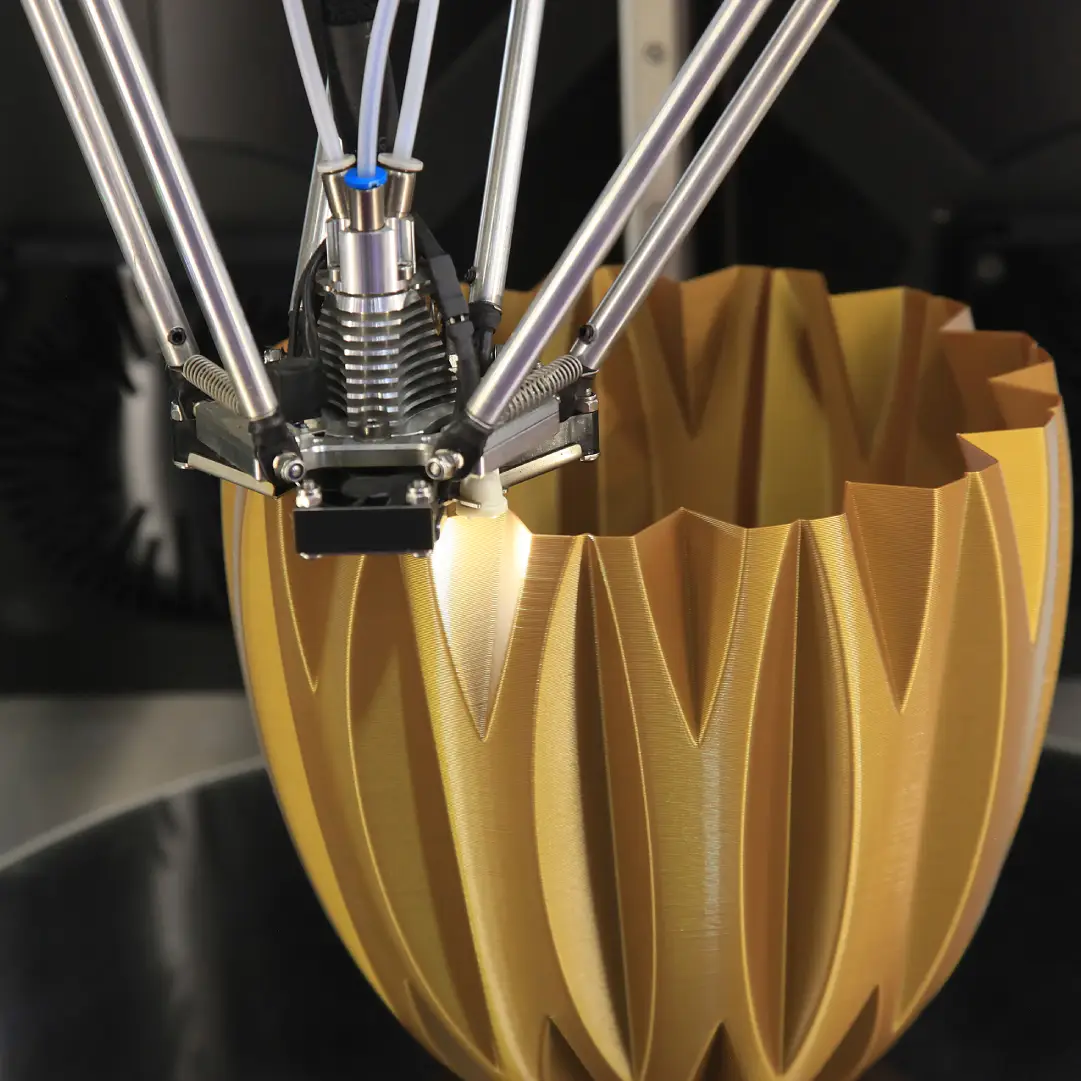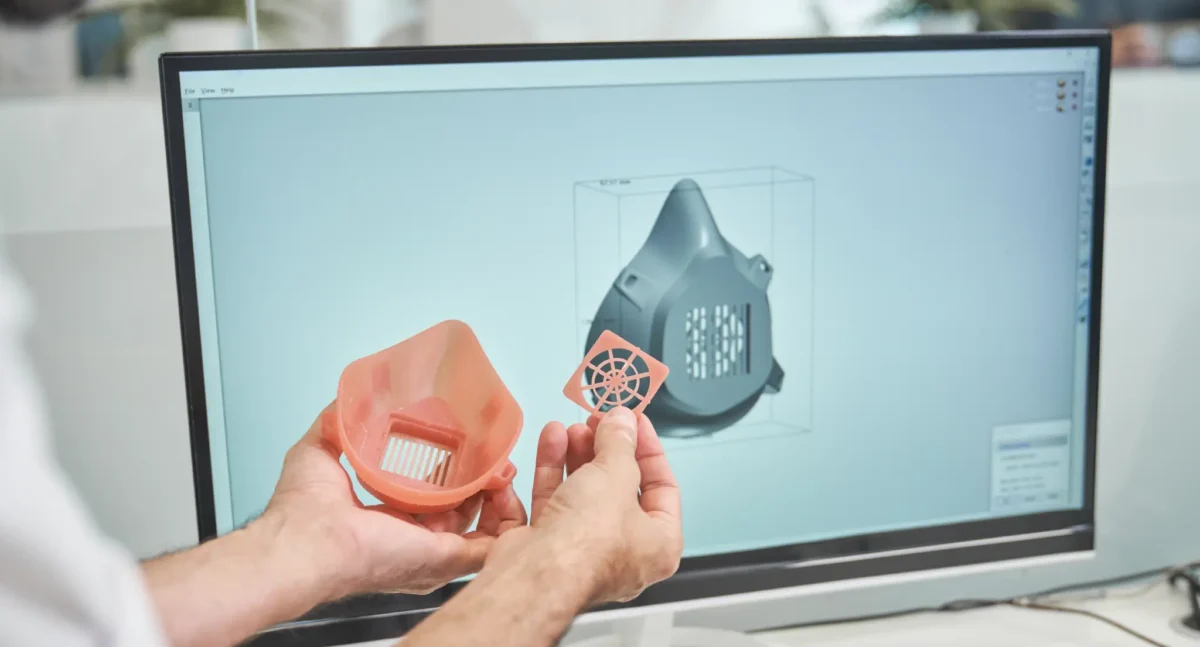If you picture 3D printing as just a machine making plastic trinkets and collectibles, you’re missing the bigger picture. For us at Shark Design, a product design and development company, 3D printing is the lifeblood of modern innovation. It’s the bridge between a fleeting idea and a tangible, market-ready product.
This technology, known in our industry as Additive Manufacturing or Rapid Prototyping, has fundamentally changed the game. It has dismantled the old, slow, and expensive barriers to creating new products. In this article, we’re pulling back the curtain to show you exactly how we harness the power of 3D printing in product design to bring ideas to life faster, smarter, and more effectively than ever before.
What is 3D Printing in Product Design, Really?
At its core, 3D printing is a process of creating a physical object from a digital file by building it layer by layer. Think of it like a highly precise, robotic hot-glue gun that follows a digital blueprint with incredible accuracy.
But for product designers and engineers, it’s so much more. It’s a digital workshop at our fingertips. It allows us to:
-
Touch and Feel an Idea: Transform abstract concepts on a screen into something you can hold in your hand within hours.
-
Test Form and Function: Verify that parts fit together, mechanisms work, and the product feels right ergonomically.
-
Iterate with Speed: Make a change to the digital model in the morning and have a new, improved version in your hands by the afternoon.
This iterative, agile process is the cornerstone of how we work at Shark Design. It empowers us to explore more possibilities and solve problems before they become costly mistakes down the line.
The Shark Design Process: 3D Printing at Every Stage

A product’s journey from a napkin sketch to a store shelf is filled with critical steps. 3D printing integrates seamlessly into each one, adding value and de-risking the entire development process.
Stage 1: Concept Modeling and Early Visualization
The Challenge: In the early stages, you have a brilliant idea, but it’s hard to communicate it to stakeholders, investors, or even your own team. A 2D drawing or a CGI render can only convey so much.
How 3D Printing Helps: We use 3D printing to create low-fidelity concept models. These aren’t the final product; they are rough, physical sketches. They allow everyone to understand the scale, basic form, and overall aesthetic of the product.
-
Client Benefit: You get to physically interact with the concept early on. This helps align everyone’s vision, sparks new ideas, and secures buy-in much more effectively than a presentation deck ever could.
Stage 2: Form, Fit, and Ergonomic Testing
The Challenge: Does the product feel comfortable in your hand? Do all the parts snap together correctly? Is the button in the right place? These are questions you can’t fully answer on a computer screen.
How 3D Printing Helps: We produce high-accuracy prototypes that mimic the final product’s geometry. We can print multiple iterations of a handle to test which one is most ergonomic, or print an assembly to ensure all components fit together perfectly.
-
Client Benefit: We catch design flaws when they are cheap and easy to fix—not after investing tens of thousands in expensive injection molding tools. This saves significant time and money and leads to a superior, more user-friendly final product.
Stage 3: Functional Testing and Validation
The Challenge: Will the product survive real-world use? Does the gear mechanism work smoothly? Can the housing withstand impact? The product needs to be more than just pretty; it needs to be durable and functional.
How 3D Printing Helps: This is where technology truly shines. With a wide range of advanced materials, we can create functional prototypes that are tough, heat-resistant, or even flexible. We can print a working prototype of a mechanical gearbox, a drone arm that needs to be lightweight and strong, or a custom jig for the assembly line.
-
Materials we might use: Engineering-grade resins, nylon, or even carbon-fiber reinforced composites.
-
Client Benefit: You gain unparalleled confidence in your product’s performance before mass production. We can validate the design under real-world conditions, ensuring reliability and building trust with your future customers.
Stage 4: Manufacturing Aids and Custom Tooling
The Challenge: The assembly process needs to be efficient and error-free. Custom tools, jigs, and fixtures are often needed, but having them custom-machined is slow and expensive.
How 3D Printing Helps: We design and 3D print custom manufacturing aids. These are tools used on the factory floor to hold parts in place, guide assembly, or ensure perfect alignment every time. They are lightweight, can be ergonomically designed for the assembly worker, and can be produced in-house overnight.
-
Client Benefit: A faster, more efficient, and higher-quality assembly process. It reduces human error and streamlines the path to mass production, saving both time and operational costs.
The Tangible Benefits: Why This Approach is a Game-Changer
When you integrate 3D printing deeply into your product design workflow, the advantages are undeniable.
-
Unmatched Speed and Agility (Rapid Iteration): The traditional design cycle could take weeks for a single iteration (design, send out for prototyping, wait, review, repeat). With an in-house 3D printing lab, we can cycle through multiple iterations in a single week. This “fail fast, learn faster” mentality means we arrive at the optimal design in a fraction of the time.
-
Significant Cost Reduction: It’s simple: finding a flaw in a $100 3D printed model is infinitely better than finding it in a $10,000 injection mold. 3D printing drastically reduces the cost of failure, allowing for more creative exploration and risk-taking without financial peril.
-
Radical Design Freedom and Complexity: Traditional manufacturing methods like machining are “subtractive” (you start with a block of material and cut away). 3D printing is “additive,” building complex geometries layer by layer. This allows us to create organic shapes, internal lattices for lightweight strength, and consolidated assemblies that would be impossible or prohibitively expensive to make any other way.
-
De-risked Product Development: By physically validating every aspect of the design—from form and fit to function—you move into mass production with a high degree of certainty. This reduces the risk of costly recalls, redesigns, and market failure.
Real-World Applications: 3D Printing in Action at Shark Design
Let’s move beyond theory. Here are a few ways we’ve used 3D printing to solve client challenges:
-
The Medical Device Startup: A client needed a handheld medical tool that was both ergonomic for long-term use and housed complex internal electronics. We 3D printed over a dozen ergonomic variants for user testing, allowing doctors to provide feedback that shaped the final design. We then printed a functional prototype in a bio-compatible-like material to validate the assembly and feel before tooling.
-
The Consumer Electronics Company: Developing a new smart home device, the client was unsure about the placement of vents for optimal airflow and heat dissipation. Instead of guessing, we printed the internal structure and used smoke tests on the prototype to visually see the airflow, allowing us to optimize the vent design for peak performance.
-
The Sustainable Goods Brand: We helped a client design a modular product where parts could be replaced individually to avoid throwing the entire item away. 3D printing allowed us to quickly prototype and test the interlocking connection points, ensuring they were robust and user-friendly for assembly.
Looking Ahead: The Future of 3D Printing in Product Design
The technology is still evolving at a breathtaking pace. At Shark Design, we are constantly exploring new frontiers:
-
End-Use Parts: For low-volume or highly customized products, we are already using 3D printing for final production parts.
-
New Material Science: The development of new materials with properties identical to traditional plastics and even metals is opening up even more possibilities for functional prototyping and manufacturing.
-
Mass Customization: 3D printing makes it economically feasible to create products tailored to an individual’s specific needs, from custom-fit wearables to personalized medical implants.
Conclusion: Your Idea, Perfected
3D printing is not just a tool in our workshop; it’s a fundamental part of our philosophy at Shark Design. It empowers us to be better partners to our clients, transforming the complex and often intimidating journey of product development into a streamlined, collaborative, and creative process.
It allows us to swim faster and smarter through the challenges of bringing a new product to life, ensuring that when your idea finally hits the market, it’s not just another product—it’s the best possible version of your vision.
Ready to bring your product idea to life with speed and precision? Contact Shark Design today for a free consultation, and let’s discuss how our 3D printing-driven design process can work for you.

